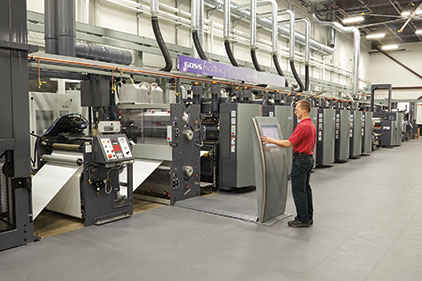Labels & Labeling: Labels/Shrink Sleeves
The Web Offset Pay-off for Labels and Sleeves


|
| The Goss Packaging Technology Center in Durham, New Hampshire |
For those who have never investigated web offset as a solution for label production, the suggestion that it can work out more cost-effectively is sometimes greeted with surprise or disbelief. Nevertheless, as competition continues to increase in all areas of the supply chain and across all product sectors, label printing and converting today face an ongoing challenge that fails to be addressed by conventional practice.
Fierce competition among consumer goods is forcing fast-moving consumer goods producers to find ways of reducing inventories and manage just-in-time production more efficiently. At the same time, and with space on the supermarket shelf at a premium, they need to ensure stand-out product packaging. In a bid to be the most eye-catching and appealing, brands continue to create ever more stock-keeping units while employing the latest 360-degree design techniques. In-mold, wraparound and shrink labels – featuring special inks, lacquers and an extended color gamut – are rapidly growing in popularity for their ability to transform the whole product into a canvas for brand promotion and maximize opportunity for differentiating product varieties.
All these factors increase the pressure on converters. While they contend with reducing run lengths and demand for faster turnarounds – without any increase in unit price – they simultaneously have to introduce the latest production trends, new materials and effects. The challenge would seem to call for a magic solution that combines the fastest makeready, lowest setup costs and highest print quality, with the widest variety of production processes and complete flexibility of substrate and consumables.
The Combination Solution
Most labels and packaging press lines sold today are, to a greater or lesser extent, hybrid because brand owners want the best for every aspect of their product; but there is no single print process that is best at everything. Combining a wider array of technologies into a single integrated system provides the converter with flexibility in terms of designs and effects; economics in terms of image costs (offset’s big advantage); print quality in terms of both image detail; and effects; such as opaques, metallics, protective coatings, etc.
Whatever the mix of processes required to print a particular packaging product, the crucial factor is profitability and the need to maintain a viable business model. Each additional process comes with potential complications in terms of makeready, changeovers and overall production times. Clearly, workflows should be as integrated and seamless as possible.
Although there’s no one-size-fits-all solution, web offset makes an ideal base for a combination printing system in delivering low-cost image changes and high print quality, while easily integrating the inherent advantages of flexo, gravure or digital stations.
Short-run Flexibility
Demand for high-quality print in shorter runs with fast turnarounds, driven in the main by increases in SKUs, is squeezing margins and increasing stress on production teams. Flexo and gravure operations are feeling the pinch from run length reductions most acutely – not from the niche micro volumes that are purely the domain of digital printing, but the runs of 15,000 to 50,000 feet. Previously, such jobs were often loss leaders, taken on to retain regular, longer-run business. Today, those once-exceptional jobs are becoming the norm, and are beginning to threaten the ongoing viability of some converting businesses.
Handling 15-plus jobs per day when your operation was initially designed to handle five or six can create a perfect storm of time-consuming (and expensive) plate-making/engraving and make-ready, high levels of start-up waste, unacceptable levels of downtime and disappearing profits. While sleeve technology enables much faster plate mounting, it does not address the fundamental issue of plate-making/engraving time and costs. Although finishing issues are largely the same regardless of printing process, the impact on a finishing line of presses that are halted for increasingly frequent makereadies
Another issue closely related to flexo platemaking is the rising demand for an extended color gamut. Flexo presses with capabilities to handle eight to 10 colors are able to meet these color requirements – but not without requiring more time and incurring additional cost.
Today’s web offset presses offer capabilities that can turn marginal short-run jobs into sustainable, profitable ones. It has the distinct advantage of delivering plate costs that are a fraction of those associated with flexo and gravure. The relative simplicity of offset plate making allows converters to manage the process in-house rather than buying plates or engraved cylinders from external suppliers. It also ensures far greater flexibility and control, and allows converters to offer their customers later artwork deadlines.
Other capabilities that reinforce the case for its suitability include: print quality, greater color control and a standardized process, as does the ability to handle a wide variety of substrates, including films as fine as nine microns, at high speeds.
Offset presses are also able to match up to 98 percent of the Pantone color range, often with only five to seven colors.
The Goss Sunday Vpak series of presses builds on these inherent advantages through innovative variable sleeve technology featuring quick-change blanket and plate cylinder sleeve adapters that make ‘infinitely’ variable repeat lengths even easier and more affordable. Additionally, for ultimate flexibility there are the future-proofing capabilities of a system that not only offer a solution for labels, but can also adapt to additional applications as market conditions change.
Goss International
(603) 749-6600; www.gossinternational.com
Looking for a reprint of this article?
From high-res PDFs to custom plaques, order your copy today!






